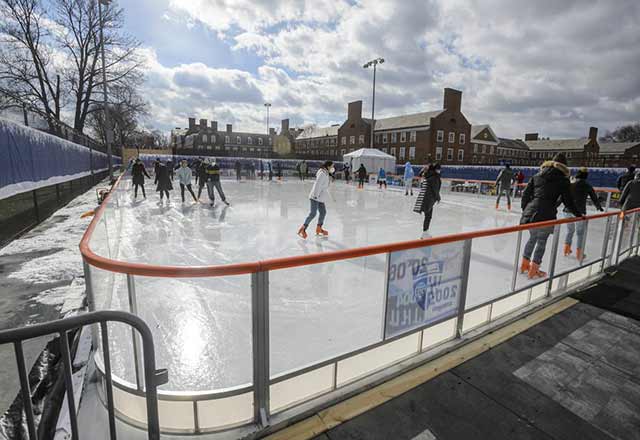Skating is something I learned to do by falling on the ice — a lot. When I was a junior in high school, I joined the JV hockey team, without really knowing how to ice skate. The very first thing I learned was how to fall safely on the hockey pads. Even so, I was covered in bruises the first week, as I tried to learn how to skate in a proverbial sink-or-swim situation. I attempted the power skating and quick turns of my infinitely better teammates, and somehow I learned how to skate in a short period of time. To my surprise, I also learned quickly how to sprint on ice and make full hockey stops.
A pop-up ice rink opened on The Johns Hopkins University’s Homewood campus this winter. It came as a welcome surprise, since my quick-and-dirty method of learning skating left me with some gaps: I hadn’t fully learned how to skate backward or to do crossovers (the outer skate crosses over the inner skate during turns). I could sprint on the ice and whiz around in turns, but my techniques were not very refined or graceful. I skated on my lunch hour at the Homewood ice rink every day, working on my skating skills.
Part of the amusement at an ice rink is watching novices learn to skate. It is a bit like watching a toddler make the first steps – it’s very unbalanced, with arms flailing. Some take very cautious steps on the ice with their hands tightly gripping the guardrails, while others are quite fearless, and often unable to stop. The tradeoff between speed and safety is self-evident.
As a neuroscience graduate student studying how our brains control body movements, I spend a lot of time thinking about how the brain learns new motor skills, including during ice skating. Part of what makes skating so difficult to learn is that the skating movements are not very visible. The major motion is to shift weight from one foot to the other. In fact, you can skate without lifting a foot. Unlike a tennis serve, which uses arm muscles, this movement uses postural muscles, which are quite invisible to an observer, so the movement is hard to emulate. Another reason that ice skating is difficult is that the sensation is unfamiliar. Our sense of balance originates from the inner ear, which detects our position in space, and we sense our muscle movements through mechanoreceptors in the muscle fibers and joints that detect muscle stretch and joint angle. Usually, these crucial processes occur in the unconscious background as we perform movements. While turning and gliding on ice, however, these sensations differ drastically. It comes as no surprise that novice skaters often look like they are about to fall, as their skates slip out from underneath them.
As I spent more time at the rink, I decided to put my neuroscience knowledge to practical use. To teach myself new skating skills, I thought explicitly about my posture, my center of gravity and the position of my lower limbs. The trick was to bring the unconscious parts of learning a new motor skill to the conscious forefront. I constantly readjusted my posture and paid attention to the positioning of my legs and my sense of balance. A hallmark of motor learning is that learned movements become faster and less variable, and as expected, my backward skating and crossovers became more fast paced and consistent. My neuroscience training paid off dividends.
It’s not every day that I get to apply my neuroscience knowledge in ordinary settings. Despite spending a month on the ice, I am still no figure skater, as I cannot do complicated twists or jumps. But, like all motor skills, the fancy moves can be learned. All it would take is a lot of patience and a bit of applied neuroscience.
Related Content
- The P-value of People
- Why Do Students Pursue a Ph.D. in Neuroscience?
- Multiple Mechanisms Underlie Human Motor Learning
Want to read more from the Johns Hopkins School of Medicine? Subscribe to the Biomedical Odyssey blog and receive new posts directly in your inbox.
